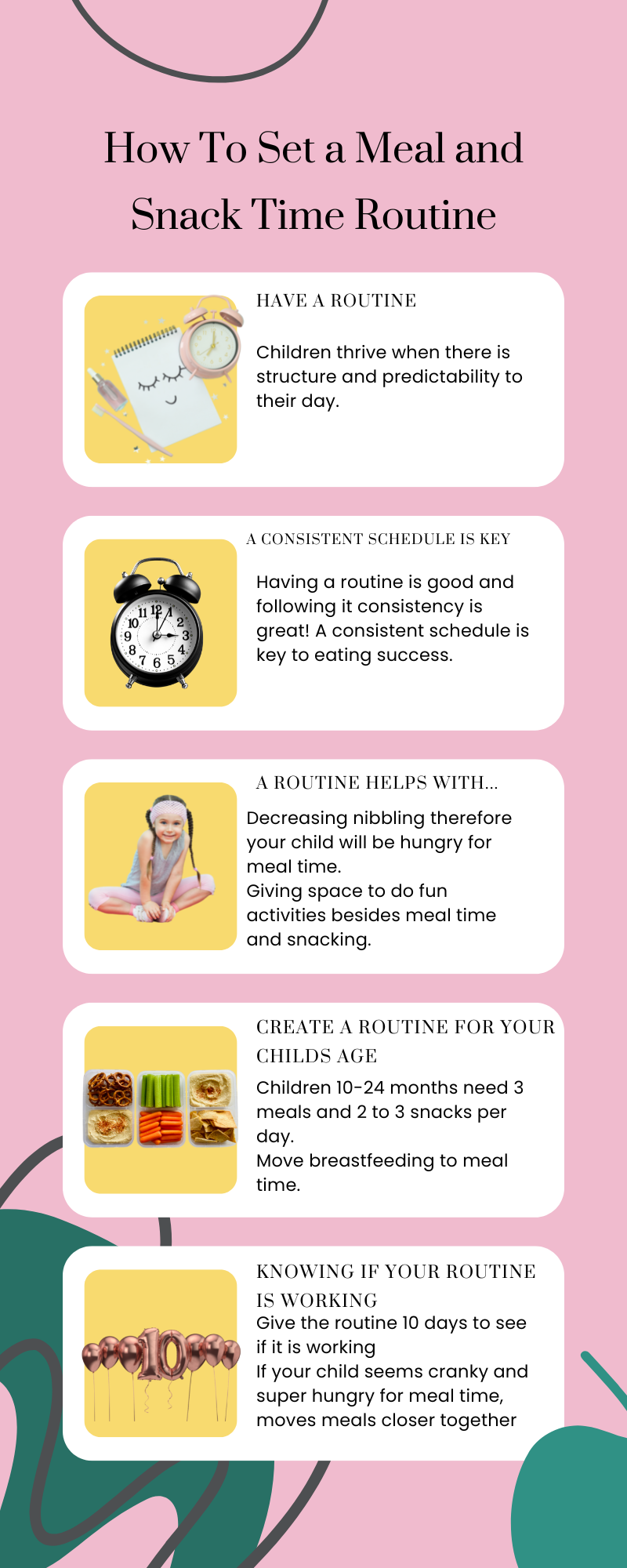How to Set a Meal and Snack Routine
How often to serve snacks and meals to kids? Part 1: Ages 10-24 months
📣 Introduction
Life is hectic and trying to stick to a plan is a challenge. Believe it or not, having no routine is worse - and stressful for kids! Children thrive on predictability and structure. This doesn’t stop you from spontaneously going to a barbeque next door - being flexible is fine. But having a consistent day-to-day routine is the key to eating success.
Adapting to a routine takes time and effort, however it will be worth it! Give your child and yourself time to become accustomed to the new routine. Write it down or hang it up on your fridge! Make the routine become apart of your daily life.
🤷♀️ How a routine helps
A consistent routine for meals and snacks helps your child to feel hunger and fullness. Eating in response to hunger and fullness (what we call self-regulation) is a key part of a life-long positive relationship with food.
💡 Nibbling on food all day means children never really feel hungry or full and will likely be less interested in eating main meals.
💡 Eating regularly is important because kids’ bellies are small - they need regular refills!
💡 Having space between meals and snacks is just as important. Space between meals helps build up an appetite, and it leaves time for other things too - like playing, learning, and going to the park.
There is more to life than food!
👶🧒 A routine that suits your child’s age:
⏰ Kids at this age need 3 meals and 2-3 snacks per day, spaced about 2 or 3 hours apart. Stand-alone breast- or bottle feeds can be counted as snacks.
🍼 Move breastfeeding or bottle feeding to set meal and snack times, rather than on-demand. This ensures that your child is hungry for their meals and snacks.
🥯 If offering breastmilk/milk/formula together with solids, try offering solid foods first, especially for children over 12 months.
🤱 Many children at this age like to breastfeed or drink milk/formula as soon as they wake up. They also like to finish their days by breastfeeding or drinking milk/formula at bedtime.
⌛️ Keep eating contained to a 20-30 minute window so that your child is not grazing on their food for so long that it impacts their appetite for the next meal.
🥛 For kids over 12 months, keep all milk and formula to under 2-3 servings (2-3 cups) a day and less if your child eats cheese and yogurt daily.
🚫 Milk cannot be offered as a main drink to babies under 12 months.
💧 Try to offer nothing but water outside of the planned eating times.
⏰ Sample routine for a 10-24 month-old
Upon waking up – Breast milk or milk/formula (optional)
8 am - Breakfast
10 am - Mid-morning snack (can be just breastmilk/formula for kids under 12 months)
12 pm - Lunch
3 pm - Mid-afternoon snack (can be just breastmilk/formula for kids under 12 months)
5:30 pm - Dinner
7 pm Before bed – Breast milk/formula or milk (optional)
🤷♂️ How do you know if your routine is working?
It takes a bit of trial and error. Give it time - try it out for at least 10 days before deciding whether or not you need to re-think the routine.
Is your child super hungry before their meal or snack? Are they really cranky? Do they get so hungry that they get upset easily and can’t eat? Review your routine and move meals and snacks a little closer together.
Is your child not interested in coming to the table when dinner is ready? Do they never seem to be hungry? You may need to space meals and snacks further apart or remove one of their snacks from the routine.
Your child’s nap schedule changed? See if you need to shift the meal and snack schedule to accommodate the change.
📃 Summary
Creating a routine is not only beneficial for you, but your child as well! Babies and toddlers need to eat regularly, every 2-3 hours. Remember to give it 10 days before deciding whether or not the routine is working. Next week we will go over ending meal time, being flexible when it comes to your routine, meal time phrases and proactive steps!
Until next time,
Easy Bites


